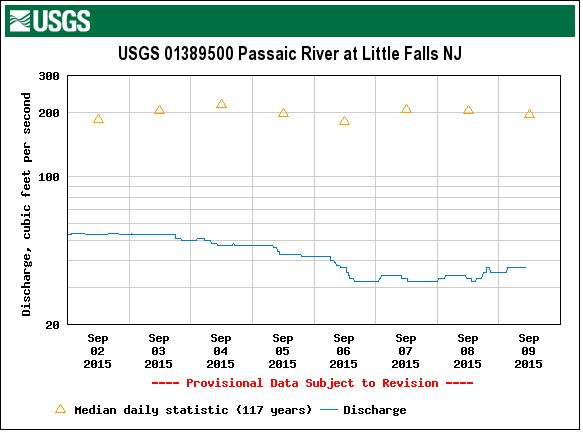Is the Passaic River Approaching Critical Low Flow Conditions?
What Does That Mean For Drought?
What Does That Mean For Safety of Drinking Water?
Fact Checking Passaic Valley Water Commission Statements
Jim O’Neill has another drought story running today, and he got it wrong again – this time by omission and commission, see:
We have urged O’Neill to write about the relationships between pollution, water quality, and drought which are obvious and critical concerns in the Passaic basin (it’s a old story – here’s a good news story and here’s a bad news story and here is a local perspective and here is the cover story:
Nitrate in drinking water at levels above 10 ppm is a health risk for infants of less than six months of age. High nitrate levels in drinking water can cause blue baby syndrome. Nitrate levels may rise quickly for short periods of time because of rain fall or agricultural activity.
Note again how the drinking water suppliers’ water quality reports downplay the problem and even ignore the sewage treatment plants as a pollutant source for nitrate:
PVWC withdraws water from the Passaic River in Totowa, New Jersey and treats it at the Little Falls WTP. In the event of water quality issues in the Passaic River, PVWC can also withdraw water from either the Pompton River or the Point View Reservoir (which is filled from the Ramapo River). A water quality monitoring station is operated by the U.S. Geological Survey on the Passaic River shortly upstream of the Little Falls WTP intake and just downstream of the Passaic River’s confluence with the Pompton River. This monitoring station provides continuous data for important water quality parameters, and helps provide advanced warning of adverse changes in water quality. PVWC also conducts a surface water monitoring program at various stream and river locations throughout the Passaic River watershed.
Typical source (nitrate) : Runoff from fertilizer use; Leaching from septic tanks, sewage; Erosion of natural deposits
When there is little rainfall, the flows of the River are correspondingly low. When rainfall and river flows are low, as a result of scores of sewage treatment plants, pollution levels in the Passaic River are high.
At some point, pollution levels become so high that water from the river can not be pumped to refill the Wanaque Reservoir and may not be taken directly from the river by intakes for water supply.
When a prolonged rainfall deficit occurs or a drought is recognized, towns along the Passaic tend to conserve water. That in turn reduces wastewater flows from the sewage treatment plants and further reduces the flows of the Passaic River and increases pollution concentrations.
Today, O’Neill quotes Joe Bella, Director of the Passaic Valley Water Commission as follows:
Bella said the Passaic Valley Water Commission, which serves Paterson, Passaic, Clifton and other towns, has no current plans to restrict water use. It gets the bulk of its supply by pumping water out of the Passaic River and treating it at its facility in Little Falls. While the Passaic River’s flow is down considerably, it is still at 150 percent of what the state allows the commission to remove from the river, Bella said.
After his last drought/Passaic River story ran, I sent him a link to a NJ Geological and Water Survey Report on minimum passing flows, see:
O’Neill obviously failed to read that report or he failed to apply it to current conditions.
According to NJ Geological Survey, the minimum passing flows set for the Passaic Valley Water Commission are as follows (see Appendix B)
The Passaic Valley Water Commission now has a passing flow of 27.2 cfs (17.6 mgd) in the Passaic River at Little Falls for withdrawals at Two Bridges (pf099 in Appendix B).
So, if the Passaic River was flowing at 150% of that minimum passing flow as Mr. Bella claimed, it would be 48 cfs.
Keep in mind that over 100 years of flow data on the River show that the median daily flow for this time of year is about 200 CFS, almost 8 TIMES the minimum passing flow. (see above chart)
According to the most recent US Geological Survey Passaic River flow data, the current flow (9/9/15) is as follows:
Little Falls (USGS Gauge # 01389500) – 37 cubic feet per second (see above chart)
Basic math tells us that Mr. Bella exaggerated the flow statistic – (and the flow has increased over the last few days, it was even lower on September 6, 7 and 8).
But the flow statistics are just one part of the problem – the other part is water quality.
When the river is flowing this low, it is made up of virtually 90 – 100% wastewater flows from upstream sewage treatment plants.
Therefore, the concentrations of pollutants is high – most critically the 500 or more chemicals known to be present but not regulated and perhaps the most critical regulated parameter, which is nitrate.
The drinking water standard for nitrate is 10 milligrams per liter. (10 ug/L)
Nitrate is not removed by drinking water treatment facilities, so we need to know what the nitrate level in the River is.
If it is approaching 10 ug/L, the DEP may shut down the water supply intake.
That would create a hugh problem for drought managers.
What would Mr. Bella do? Would he begin to conserve water?
Also, Mr. Bella failed to note that pumping of river water to the Wanaque reservoir is restricted by DEP due to poor water quality – so again water quality and drought are related.
How hard would it be for O’Neil to ask Bella and DEP what the nitrate levels in the River are?
My guess is that it is more than 5 ug/L – approaching a critical level.
When will we get answers to that question?
